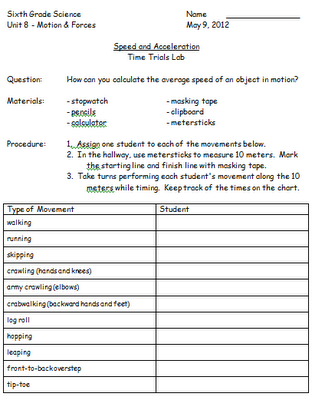Before the time trials, we ran through the procedure with the lab sheet below and assigned different types of movement to each student. We then moved out into the hallway and measured a ten-meter track, marking the starting line and finish line with masking tape. Each student performed a time trial on the track with their assigned activity - everything from walking to log rolling.
This year, I adapted my lab sheet to make it much simpler and more streamlined for students. I also printed a data chart on large 11" x 17" paper so that the students could see it easily, then added the speed calculations to the same chart later on.
All of the students lined up on the benches along the wall and each student took turns performing their movement. I timed each student's trial on a stopwatch and kept track of the times on the poster, shown above. Once each student had performed, we came back into the classroom and I hung the data poster in the front of the room. Each student calculated their own speed using the formula, speed = distance / time. In this case, everyone had the same distance - 10 meters. As each student told me their time, I recorded them onto the poster. Just like last year, we graphed the speeds.
Earlier this week, I had a student's older teenage sister tell me that she had learned the same concepts in her physics class in 11th grade. There is no doubt that studying physics includes many challenging concepts and math skills that can be discouraging to some students. With activities like our time trials, however, many students remember the Motion and Forces Unit as one of their favorites!










0 comments:
Post a Comment